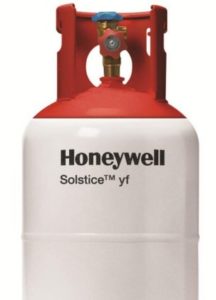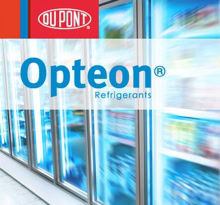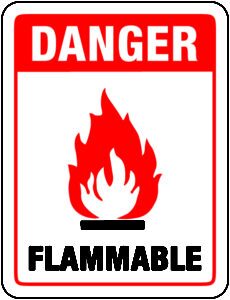HFO refrigerants, or Hydrofluro-Olefins, are a new class of refrigerants that have a much lessened global warming potential than it’s HFC alternatives. One example being the 134a alternative, 1234YF, which is 335 times lower on the global warming potential scale and only four times higher than standard carbon dioxide.
HFOs are the refrigerant of the future… for now. I say for now because we’ve been through this before. A new refrigerant is introduced and then something is found to be harmful in that chemical and the refrigerant is replaced with a new and better line. Maybe HFOs are the perfect refrigerant, but I have a feeling we’ll be going through this again and sooner rather than later. Let’s keep everyone on their toes…
HoneyWell’s New Solstice Line

Honeywell is one of the three big refrigerant manufactures in the world and are the ones to watch for new industry trends. Honeywell announced this week that they have begun production on four new HFO refrigerants under their Solstice brand name. You can view their press release on the Honeywell website. These steps are being taken in accordance to the agreement HoneyWell made with the Obama administration to diminish the use of HFCs and to begin creating alternative refrigerants.
A breakdown of their new refrigerants are shown below.
Honeywell’s new offerings include:
- Solstice zd
A nonflammable HFO refrigerant with a GWP equal to 1, for use in low pressure centrifugal chillers, which are most often used to cool large buildings. Trane, a leading air conditioner manufacturer, has already announced that it will use Solstice zd in its new Series E CenTraVac large capacity centrifugal chillers in Europe, the Middle East and other 50hz markets. - Solstice ze
An HFO refrigerant that can be used in equipment that traditionally used R134a (i.e., chillers and refrigeration equipment). Solstice ze offers a GWP of less than 1, which is 99.9 percent lower than the GWP of R134a. - Solstice N13
An HFO blend for chillers, as well as medium-temperature applications such as supermarket display cases and self-contained refrigeration units that require a non-flammable refrigerant solution. Solstice N13 is designed to replace R134a and offers a GWP that is 60 percent lower than the GWP of R134a. - Solstice N40
An HFO blend for low- and medium-temperature refrigeration equipment such as supermarket freezer cases. Solstice N40 is designed to replace HCFC R22 and HFC R404A, and offers a GWP that is 66 percent lower than R404A. In supermarket trials conducted in the U.S. and Europe, Solstice N40 demonstrated three percent lower energy consumption in low-temperature applications and 5 to 16 percent lower energy consumption in medium-temperature applications as compared to R404A.
DuPont’s New Opteon Line

Just as Honeywell has begun producing new HFO refrigerants DuPont is doing the same. They have introduced three new HFO refrigerants and are expecting to introduce many more in the near future. The three new HFOs from DuPont are as follows:
- Retrofit Refrigerant | Opteon™ XP40 (R-449A)
XP40 is designed to replace the 404A HFC refrigerant. This is commonly used in commerical buildings, super markets, and other chillers. - Industrial and Transport Refrigerant | Opteon™ XP44 (R-452A)
XP44 is also designed to replace 404A but on the refrigerated transport side. - Opteon™ XP10 (R-513A) Refrigerant | Opteon™ Refrigerants
XP10 is DuPont’s replacement for the automotive 134a Refrigerant.
Say Good Bye to HFCs

It seems like they just got there but HFCs are already being phased out across the world. HFCs were the alternative to the O-Zone damaged CFCs of the 20th century. The R-12 and R-22 CFCs contained high amounts of Chlorine and it was found that Chlorine damaged the O-Zone. So, the CFCs were phased out and replaced with the HFCs which had a substantially lower amount of Chlorine compared to it’s predecessors.
Well, R-134a was banned in the European Union a few years ago and now it is being pushed for voluntary phase out in the United States. Many automobile manufacturers have already begun to switch to the new HFO alternative 1234YF refrigerant. If you were to buy a car from 2014 or 2015 chances are it will be taking the new 1234YF. General Motors has even announced that all of it’s new vehicles will be switched over to 1234YF by 2018.
But, it’s not just the R-134a that is going away. Many companies are working on eliminating R-404A HFC Refrigerant as well. Now, the market on 404A isn’t as HUGE as 134a but it is still substantial to larger commercial buildings, super markets, and even refrigerated trucks. This will still make an impact, but it will be minimal to the 134a switch.
On top of 134a and 404a I noticed that HoneyWell’s N40 brand is designed to be a replacement for 404a AND R-22. You know what that means. Even though everyone has just switched over to R-410A in 2010 it looks like it’s days are already numbered. Now, I have not seen any company actively targeting switching away from 410A but it is worth noting that they are making HFO alternatives. It’s only a matter of time before 410A is added to the list that 134a and 404a are on.
Pricey Pricey Pricey

Are you used to paying around $100 for your 134a cylinders? How about $90 for your 410A? Well, it’s just a little bit different with the new HFOs. And… by a little I mean about five to six times the price that you are currently paying. Now, there are a variety of reasons for the price being so high but I am only going to go into a couple of them.
The first being that since these are new refrigerants the supply is very low and the demand will be increasing… so obviously the price point is going to be high until the market balances out. Secondly, the majority of all the patents on HFOs, including 1234YF, are held by two companies… DuPont and HoneyWell. So, since these formulas are patented DuPont & HoneyWell pretty much have a monopoly on the market. It’s a pretty sweet deal. The world switches away from the harmful HFCs and over the HFOs and then DuPont/HoneyWell get to charge a arm and a leg and nobody can say a damn thing because everybody needs it.
Flammability

There has been some concern from various companies that the HFO refrigerants have a much higher flammability rate than it’s HFC predecessors. 1234YF’s main opponent is Daimler out of Germany.
They did multiple tests in 2012 and found troubling results:
“Daimler carried out a series of additional tests on the new refrigerant as part of a new real-life test scenario developed in-house which goes above and beyond the legally prescribed requirements. In the new real-life test scenario, the refrigerant is dynamically dispersed at high pressure near to hot components of the test vehicle’s exhaust system. This corresponds to a serious head-on collision in which the refrigerant line is severed and the reproducible results demonstrate that refrigerant which is otherwise difficult to ignite under laboratory conditions can indeed prove to be flammable in a hot engine compartment. Similar tests of the current R134a refrigerant did not result in ignition.” Source
There have been many tests across the world from various agencies and they have not been able to replicate this test that Daimler did. 1234YF has been approved by the United States’ Environmental Protection Agency and the European Union for automotive use. It is being the common refrigerant for automotive manufacturers to switch to. Daimler is still against the HFO and is pushing for a new Carbon Dioxide refrigerant alternative.
Conclusion
In conclusion HFOs are coming and coming fast. If you are in the EU you’ve already been dealing with them for years and if you are in the states get ready! The real question is how long will we be using HFOs until a new product comes out? There has been talk about bringing back Carbon Dioxide refrigerants but at this point no one really knows what the future holds.
And as always if you’re looking to purchase any refrigerant please visit our bulk purchasing page.